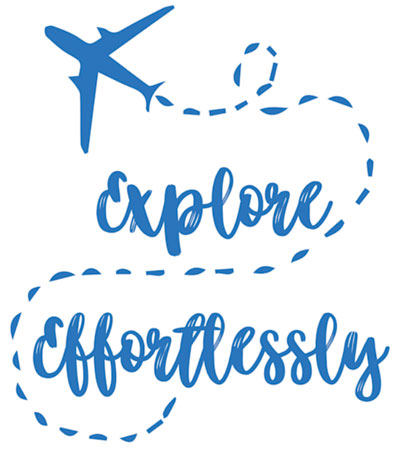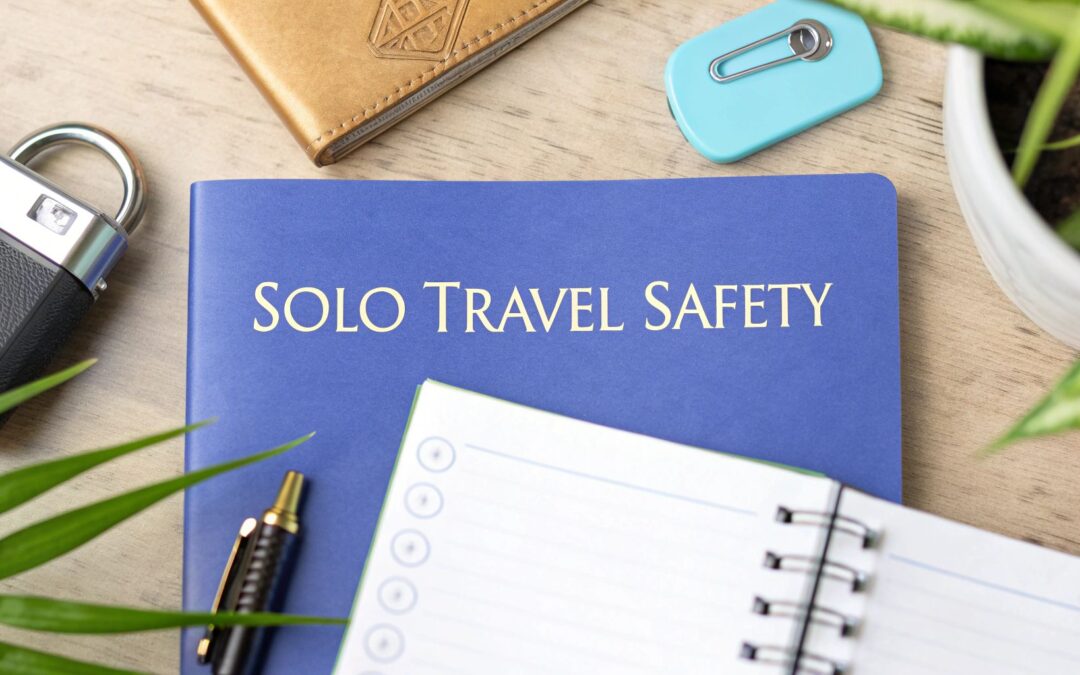Traveling solo is the ultimate expression of freedom, offering unparalleled opportunities for self-discovery and immersive experiences. For the discerning traveler, it’s not about forgoing comfort or security; it’s about elevating the journey with meticulous planning and confident awareness. As a luxury travel advisor who has earned Circle of Excellence recognition (top 5% at Nexion) and is a CLIA Accredited Cruise Counselor, I’ve guided countless clients on crafting solo itineraries that are both enriching and secure, from Miami professionals seeking a seamless Caribbean escape to executives exploring Europe.
This guide isn’t about fear; it’s about empowerment. These expert-vetted solo travel safety tips are designed to give you peace of mind, allowing you to focus on what truly matters: the transformative power of the journey. We’ll move beyond generic advice to provide actionable strategies that enhance your adventure, ensuring you can navigate new destinations with poise and assurance. For broader advice that might apply to various forms of travel and contribute to a secure adventure, consider these additional travel tips and tricks.
Key Takeaways for Solo Travel Safety
- Share Your Plans: Always leave a detailed itinerary and check-in plan with a trusted contact.
- Trust Your Instincts: Your intuition is your best safety tool. If a situation feels wrong, leave immediately.
- Secure Your Valuables: Use anti-theft gear and never keep all your cash and cards in one place.
- Research Thoroughly: Understand local customs, common scams, and safe neighborhoods before you arrive.
- Stay Connected: Ensure you have a reliable way to communicate, with backup power and offline resources.
- Choose Lodging Wisely: Prioritize accommodations in safe locations with 24/7 reception and positive reviews from other solo travelers.
Let’s explore how to make your next solo trip as effortless as it is unforgettable. If you’re ready to plan a sophisticated and secure journey, my team is here to handle every detail.
1. Share Your Itinerary with Trusted Contacts
Creating a detailed itinerary is a cornerstone of luxury travel planning; sharing it is a non-negotiable step for solo travel safety. This foundational practice establishes a crucial safety net, ensuring that trusted friends or family members always have a clear picture of your whereabouts. Should you become unreachable for any reason, they will have the precise information needed to assist authorities or raise an alarm, transforming a potential crisis into a manageable situation.
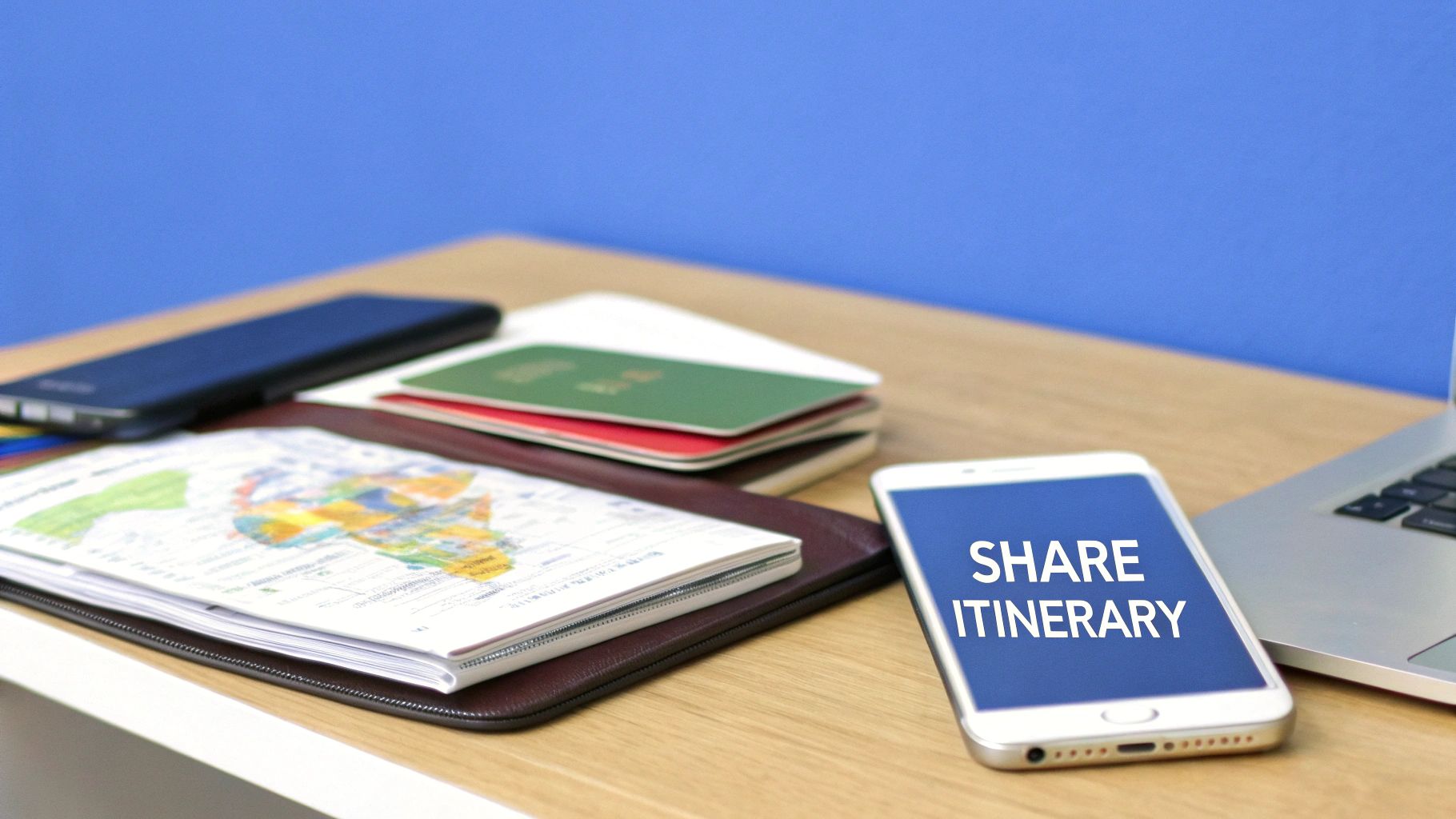
This goes beyond simply forwarding a flight confirmation. A comprehensive shared itinerary acts as a digital breadcrumb trail, providing peace of mind for both you and your contacts back home. It’s an essential solo travel safety tip that technology has made seamless to implement.
How to Effectively Share Your Plans
To make this strategy effective, your shared document should be a living, detailed resource. Modern tools automate much of this process, moving beyond static emails into dynamic, real-time updates.
- Use Itinerary Management Apps: Services like TripIt automatically compile travel plans from confirmation emails, creating a master itinerary with flight numbers, hotel addresses, and reservation details. Grant “viewer” access to a trusted contact.
- Leverage Continuous Location Sharing: Before you depart from Miami or your home city, set up location sharing through Google Maps or Find My (for iOS users). This provides a passive, real-time look at your location without requiring active check-ins.
- Establish a Check-in Protocol: Agree on a regular communication schedule, such as a quick text every 24 or 48 hours. More importantly, create an “if you don’t hear from me by X time” plan that outlines specific steps for your contact to take, including who to call first.
- Include Local Contacts: Add the phone number for your hotel concierge, your private guide, or the local tour operator to the shared document. This gives your emergency contact a local, on-the-ground resource to reach out to directly.
- Enroll in Government Programs: For U.S. citizens, enrolling in the free Smart Traveler Enrollment Program (STEP) registers your trip with the nearest U.S. Embassy or Consulate. This allows them to contact you in an emergency, whether it’s a natural disaster or family emergency.
2. Trust Your Instincts and Maintain Situational Awareness
Often called the “gut feeling” principle, this is one of the most powerful solo travel safety tips in your arsenal. It emphasizes listening to your intuitive responses to people, places, and situations. Your subconscious often processes danger cues long before your conscious mind recognizes them, and learning to trust that internal alarm system, praised by security experts like Gavin de Becker, is a non-negotiable skill.
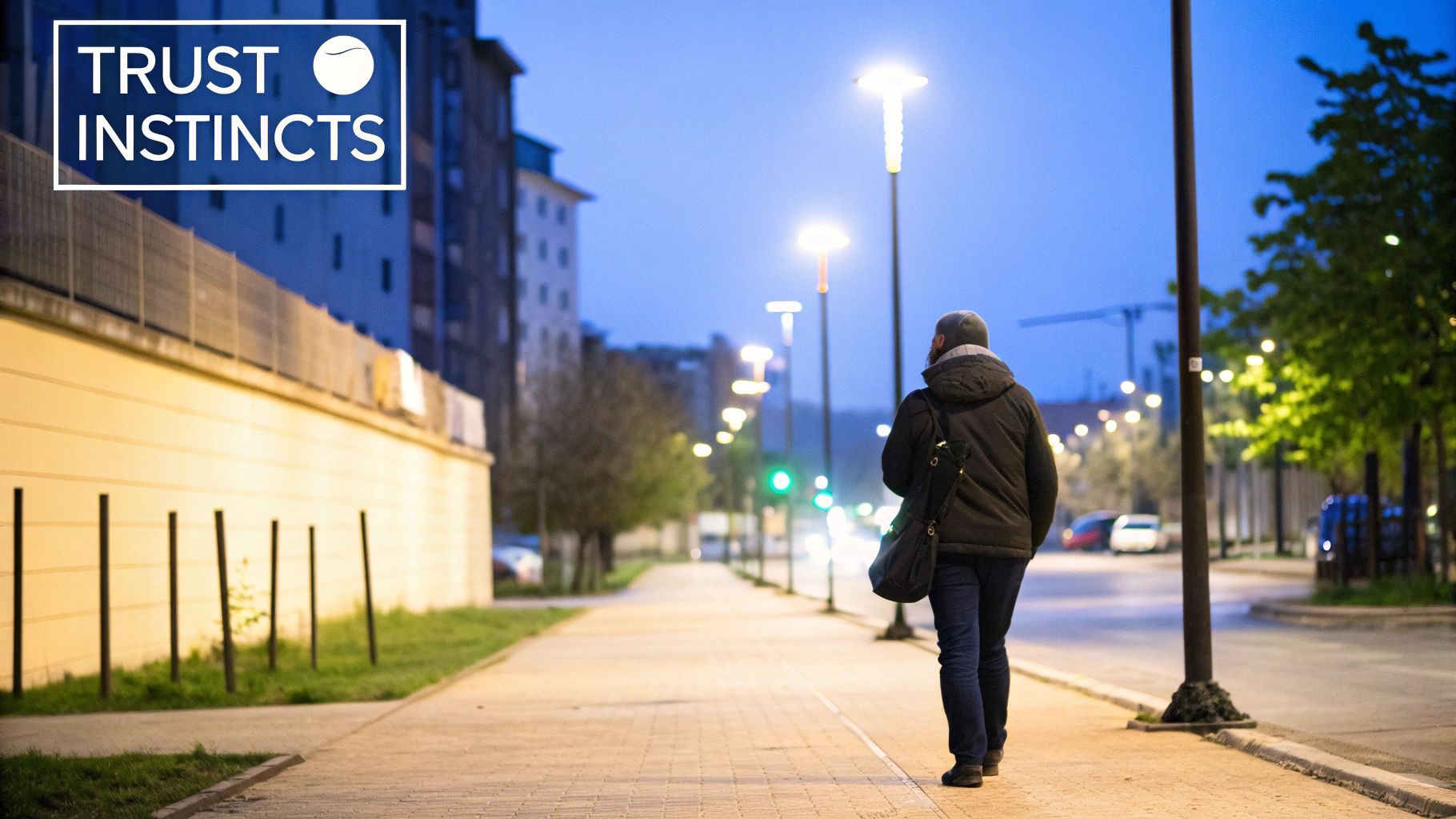
This cognitive skill involves actively observing your environment, identifying potential threats, and making informed decisions to protect yourself. It means choosing not to enter an empty train car late at night or declining an overly friendly stranger’s invitation to a secondary location. This proactive mindset transforms you from a passive tourist into an alert and confident traveler.
How to Sharpen Your Awareness
Developing strong situational awareness is a practice, not a passive state. It requires actively engaging with your surroundings and mentally preparing for various scenarios, a key focus in many European travel safety guides.
- Limit Distractions: Keep headphone volume low or use only one earbud in public spaces. Avoid being completely engrossed in your phone, especially when walking in unfamiliar areas or using public transportation.
- Identify Exits and Baselines: Whenever you enter a new space, whether it’s a café, museum, or train station, immediately note the exits. Also, observe the “baseline” of normal behavior in that environment so you can more easily spot anomalies.
- Practice the ‘What If’ Game: Mentally rehearse your response to potential scenarios. For example, “What if that person walking behind me is still there in two blocks?” This prepares you to act decisively instead of freezing in a real situation.
- Never Dismiss Discomfort for Politeness: Your intuition is a primary safety tool. If a person or situation makes you feel uneasy, remove yourself immediately without worrying about being perceived as rude. Your safety is the priority.
- Maintain a Clear Mind: Limit alcohol consumption, especially when you are alone. Intoxication significantly impairs judgment, reaction time, and your ability to perceive threats, making you a more vulnerable target.
3. Secure Your Valuables and Use Anti-Theft Accessories
A proactive approach to protecting your belongings involves a combination of specialized gear and strategic behaviors to deter theft. Solo travelers can sometimes be perceived as easier targets, making this one of the most crucial solo travel safety tips. The core strategy is to make yourself a more difficult and less appealing target than those around you through smart preparation and heightened awareness.
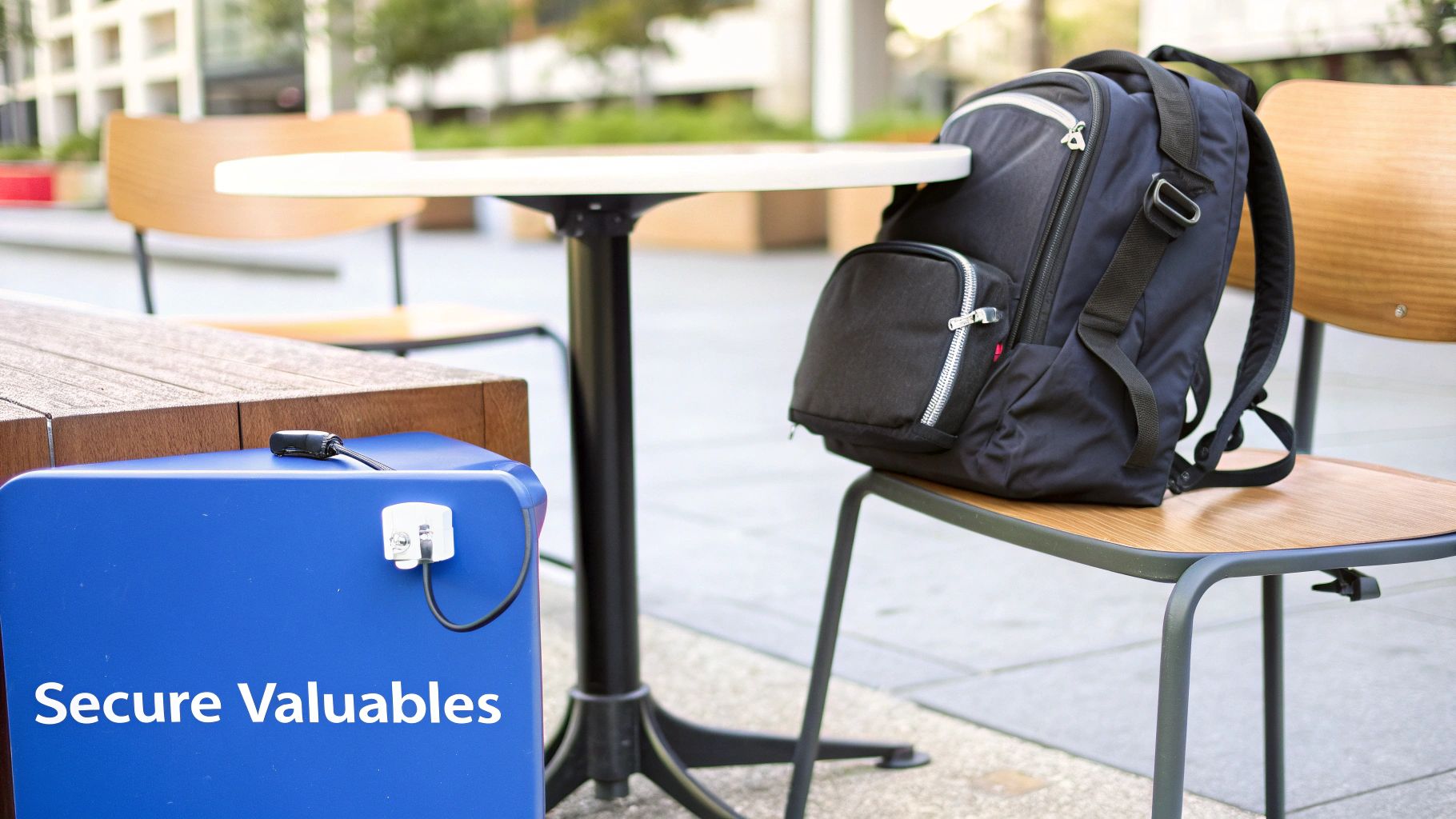
This goes far beyond a simple padlock on your luggage. It’s about creating layers of security for your passport, cash, and electronics, whether you’re navigating the crowded markets of Southeast Asia or the bustling streets of Rome. Investing in high-quality anti-theft accessories provides significant peace of mind, allowing you to immerse yourself in the experience without constant worry.
How to Effectively Secure Your Belongings
Implementing a multi-layered security system for your valuables is key. This involves both the gear you choose and the habits you adopt while on the move. Modern anti-theft products are designed to be both stylish and highly functional, seamlessly integrating into your travel style.
- Invest in Anti-Theft Bags: Brands like Pacsafe and Travelon offer bags with built-in security features like slash-proof eXomesh fabric, lockable zippers, and RFID-blocking pockets. Wear these bags crossbody style in front of you.
- Divide and Conquer: Never keep all your cash, cards, and identification in one place. Use the hotel safe for your passport and backup cards, carrying only what you need for the day. Distribute the rest in different locations, like a hidden money belt or a secret pocket sewn into your clothing.
- Carry a “Dummy” Wallet: In a front pocket, carry a decoy wallet with a small amount of local currency and some expired cards. In the unfortunate event of a pickpocketing or mugging, you can hand this over without losing your essential items.
- Secure Your Accommodations: Even in high-end hotels, add an extra layer of security with a portable door lock or a rubber door stop. This simple device can prevent unauthorized entry and enhance your peace of mind while you sleep.
- Use Cable Locks: On trains or buses, use a small cable lock to secure your daypack or luggage to a fixed object like a seat or luggage rack. This prevents grab-and-go theft when you are distracted or dozing.
For more packing advice, including what to bring and how to organize it, explore our insights on building the ultimate travel packing list.
4. Research Your Destination Thoroughly
Comprehensive pre-trip research is not just about finding the best restaurants; it’s a foundational safety practice that arms you with the most powerful tool for solo travel: knowledge. Understanding a destination’s cultural nuances, local laws, and potential risks before you even pack your bags transforms you from a vulnerable tourist into an informed, confident traveler. This proactive approach helps you sidestep common scams, avoid dangerous areas, and navigate your new environment with respect and assurance.
This level of preparation is a key solo travel safety tip that prevents missteps, from minor cultural faux pas to serious legal trouble. By investing time in research, you build a framework of awareness that allows you to fully immerse yourself in the experience, knowing you’ve minimized potential threats. For instance, understanding local transit options can prevent you from using unsafe, unmarked taxis, a common issue in many global cities.
How to Conduct Effective Destination Research
Go beyond a quick search and dive deep into resources that provide a clear and current picture of your destination. The goal is to build a practical understanding that you can apply on the ground.
- Consult Official Travel Advisories: Start with your government’s official travel advice, such as the U.S. Department of State website. These are invaluable for up-to-date information on entry requirements, health warnings, and specific regional safety alerts. They offer a baseline understanding of the macro-level risks.
- Learn About Local Scams: Familiarize yourself with common tourist scams specific to your destination. Knowing about the “gold ring” scam in Paris or the “tea ceremony” scam in Beijing ahead of time makes them easy to spot and avoid.
- Understand Cultural and Legal Norms: Research local dress codes, especially for religious sites, and be aware of any unique laws. For example, some Southeast Asian countries have strict lèse-majesté laws prohibiting any criticism of the monarchy, and certain hand gestures can be deeply offensive in other cultures. For a detailed guide on what to prepare, you can learn more about what to do before traveling to Europe.
- Map Out Safe and Unsafe Zones: Use recent travel blogs, forums, and local expat groups on social media to identify neighborhoods to avoid, particularly after dark. Download offline maps and mark your hotel, the nearest embassy, and local police stations.
- Master Key Phrases: Learn a few basic phrases in the local language, focusing on greetings and emergency terms like “help,” “police,” and “doctor.” This small effort can make a significant difference in a critical situation.
5. Stay Connected with Reliable Communication Methods
Maintaining reliable communication is not just a convenience; it’s a critical component of your safety infrastructure when traveling alone. This practice ensures you can navigate unfamiliar streets, summon help in an emergency, and provide reassuring updates to your network back home. A communication blackout, whether due to a dead battery or lack of service, can quickly turn an inconvenience into a serious vulnerability.

From landing at a new airport to exploring a remote trail, consistent connectivity provides a lifeline. This essential solo travel safety tip is about building a redundant communication plan that works anywhere, ensuring you’re never truly isolated. Planning ahead prevents a simple technical issue from compromising your security.
How to Ensure Reliable Communication
A robust communication strategy involves multiple layers, from your primary device to offline backups. Modern technology offers seamless solutions that eliminate the stress of finding reliable service on the go.
- Secure Local or Global Data: Before your flight from Miami, arrange for an eSIM through a service like Airalo, which allows you to download a data plan for your destination and activate it upon landing. Alternatively, services like Google Fi offer seamless international roaming in over 200 countries.
- Carry Redundant Power: A high-capacity portable battery pack is non-negotiable. Always keep it charged and carry the necessary cables, ensuring your primary communication device never runs out of power when you need it most.
- Prepare for Offline Scenarios: Download maps for your destination using Google Maps’ offline feature. Also, download translation apps and take screenshots of your hotel address in the local language. This guarantees you can navigate even without a data signal.
- Have a Physical Backup: Keep a small, written list of essential contacts in your wallet or daypack. Include your hotel’s number, a local emergency number (e.g., 112 in Europe), and your primary emergency contact’s phone number.
- Utilize Wi-Fi Calling and Messaging: Use apps like WhatsApp or Signal to communicate for free over Wi-Fi. Enable Wi-Fi calling on your smartphone as a backup for making calls when cellular service is weak but a Wi-Fi network is available.
6. Choose Accommodation Wisely with Safety as Priority
Where you sleep is one of the most vulnerable times for a solo traveler, making your accommodation choice a critical safety decision. This evaluation extends beyond standard reviews and pricing to a detailed assessment of location, security features, staff presence, and overall environment. A secure accommodation serves as a reliable home base, providing not just physical safety but also a place to store belongings, receive trusted local advice, and access assistance when needed.
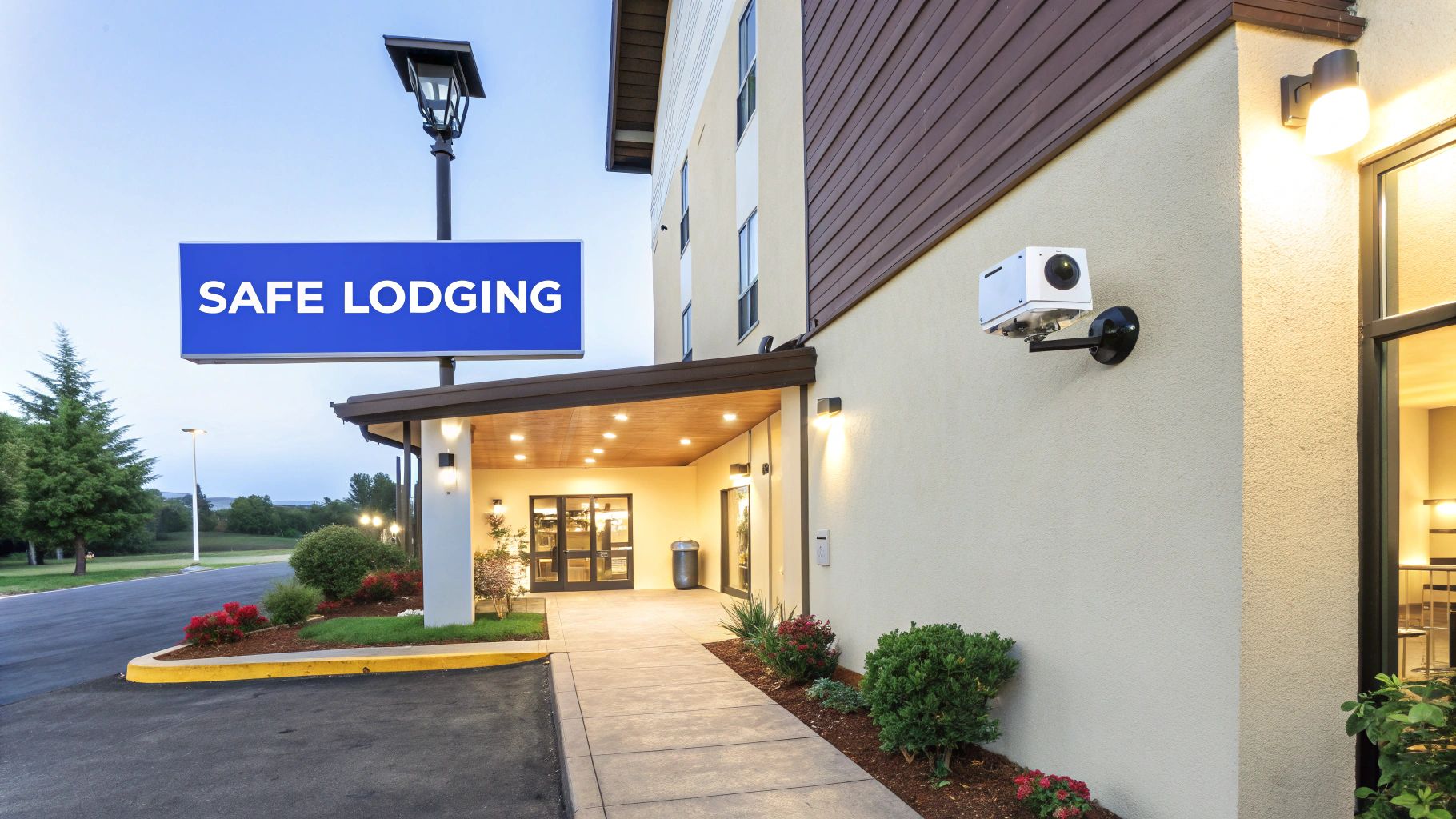
This solo travel safety tip is about building a secure foundation for your entire trip. Choosing the right place to stay allows you to explore with greater confidence, knowing you have a safe and vetted sanctuary to return to each night, whether you’re in the heart of Paris or a remote lodge in Patagonia.
How to Select Secure Accommodation
Vetting your lodging requires a multi-faceted approach that balances convenience with robust security protocols. From major hotel chains to boutique rentals, specific details can make all the difference.
- Prioritize Location and Access: Book hotels in well-lit, central neighborhoods with 24-hour reception, especially for late arrivals. Use Google Maps Street View to virtually walk the area before you commit, checking for nearby amenities and general upkeep.
- Scrutinize Traveler Reviews: Look for reviews specifically from other solo travelers, paying close attention to comments about safety, staff helpfulness, and location. Platforms like Booking.com and Hostelworld often allow you to filter reviews for this demographic.
- Verify On-Site Security Features: Confirm the property has essential features like in-room safes, electronic key card access for rooms and elevators, and robust locks on doors and windows. When choosing a rental, it’s beneficial to understand security from the owner’s side; you can review host tips for secure rental stays to see how reputable properties prioritize guest safety.
- Make Specific Room Requests: Ask for a room on a higher floor (but not the top floor) and near the elevator. This placement makes access more difficult for intruders while ensuring you have a quick route to the lobby and staff assistance.
- Add Personal Security Layers: Pack a portable door stop or a travel door lock for an extra layer of security. Never say your room number aloud in the lobby, and always trust your gut. If a property feels unsafe upon arrival, it is worth the cost to leave and find a new one.
7. Blend In and Avoid Drawing Unnecessary Attention
The art of blending in is a subtle yet powerful solo travel safety tip. It involves consciously moderating your dress, behavior, and overall presence to avoid standing out as a vulnerable or lost tourist. Opportunistic criminals often target individuals who broadcast their unfamiliarity or affluence. By aligning with local norms and projecting an air of confidence, you significantly lower your profile as a potential target.
This strategy isn’t about creating a disguise; it’s about mindful presentation. Adopting a “stealth wealth” approach and showing cultural awareness reduces friction and enhances your personal security, allowing you to immerse yourself in the destination more authentically and safely.
How to Effectively Blend In
Adopting local sensibilities requires a bit of research and a lot of observation. This proactive approach helps you navigate new environments with the ease of an insider, not the uncertainty of an outsider.
- Research and Respect Local Dress Codes: Before packing, research the clothing norms of your destination. This could mean packing modest attire with long sleeves and pants for destinations like Morocco or opting for smart-casual wear over athletic gear for an evening in a sophisticated European city like Milan.
- Carry Your Gear Discreetly: Keep expensive cameras, phones, and other electronics in a plain tote or a stylish, non-descript bag when not in use. Avoid hanging a high-end camera around your neck, as it instantly marks you as a tourist.
- Navigate with Confidence: Instead of unfolding a large map on a busy street corner, step into a cafe or shop to review your route on your phone. Walk with purpose and a confident posture, even if you’re momentarily unsure of your direction.
- Mind Your Volume and Demeanor: Be conscious of your speaking volume, especially in cultures where public spaces are quieter. Avoid loud, extended conversations in English that can draw unwanted attention in non-English speaking countries.
- Observe and Adapt: Take cues from the locals. Notice how they interact, their pace of walking, and their level of formality. Small adjustments, like carrying a local shopping bag instead of a tourist-branded backpack, can make a significant difference.
8. Have Backup Plans and Emergency Protocols Ready
Effective luxury travel is built on seamless execution, but true peace of mind comes from knowing you are prepared for the unexpected. For the solo traveler, establishing clear backup plans and emergency protocols is a critical safety strategy. This proactive approach transforms potential crises, such as a lost passport or a medical issue, into manageable inconveniences, ensuring your journey remains secure and stress-free.
This goes far beyond just having an extra credit card. It involves creating a personal emergency response system with digital and physical redundancies. This is one of the most empowering solo travel safety tips, as it gives you the confidence to handle unforeseen challenges independently and efficiently.
How to Build Your Emergency Toolkit
A robust emergency plan is a structured collection of information and resources you can access instantly. The goal is to minimize decision-making and stress during a high-pressure situation.
- Create a Digital “Emergency” Folder: Before leaving home, compile scanned copies of your passport, visas, driver’s license, travel insurance policy, and credit cards (front and back). Store them in a secure cloud service like Google Drive or Dropbox and share access with a trusted contact.
- Diversify Your Financial Access: Never rely on a single source of funds. Carry at least two credit cards from different banking institutions and a debit card, storing them in separate places. Also, keep a hidden stash of emergency cash ($200-300 in USD or local currency) separate from your wallet.
- Program and Record Key Contacts: Save “ICE” (In Case of Emergency) contacts in your phone’s address book. Separately, keep a physical or digital list with the address and phone number for the nearest embassy or consulate, your travel insurance provider’s 24/7 hotline, and the international numbers for your credit card companies to report a loss.
- Invest in Comprehensive Travel Insurance: Ensure your policy includes not just trip cancellation but also robust medical coverage and, crucially, emergency medical evacuation. Services like World Nomads or SafetyWing are popular for their comprehensive coverage tailored to independent travelers.
- Prepare a ‘Lost Phone’ Protocol: Know how to use services like Find My (iOS) or Find My Device (Android) to remotely locate, lock, or wipe your phone. Having your banking and communication apps secured with two-factor authentication adds another vital layer of protection.
About the Author: Karrah Kazravan
Karrah Kazravan is a Miami-based luxury travel advisor and the founder of Explore Effortlessly. Recognized as a top producer in Nexion’s Circle of Excellence (top 5%), she is also a CLIA Accredited Cruise Counselor. Karrah specializes in crafting bespoke, concierge-level travel experiences for discerning clients, leveraging her expert knowledge and global partnerships to ensure every journey is seamless, secure, and unforgettable.
Your Partner in Effortless and Secure Exploration
Embarking on a solo journey is one of the most enriching experiences a traveler can have. It’s an opportunity for profound self-discovery, uncompromised freedom, and a chance to connect with the world on your own terms. The strategies we’ve detailed, from meticulously sharing your itinerary to having robust emergency protocols, are not meant to instill fear. Instead, they are the foundational elements of empowerment. Mastering these solo travel safety tips transforms you from a tourist into a confident, savvy globetrotter, fully prepared to embrace the adventure that awaits.
True luxury travel is not just about opulent hotels or exclusive access; it’s about the freedom to explore with absolute confidence. While these strategies empower you, remember that the ultimate peace of mind comes from having a dedicated expert in your corner. As an Accredited Cruise Counselor and a Circle of Excellence advisor, my role is to anticipate challenges, manage logistics, and provide a seamless safety net from departure to return. Whether you’re a Miami resident planning a solo European tour or a traveler anywhere in the U.S. seeking a meticulously crafted adventure, you don’t have to do it alone. Let’s design your next solo journey together, one that’s as secure as it is spectacular.
Ready to trade travel anxiety for pure adventure? As your dedicated luxury travel advisor, Explore Effortlessly handles the intricate safety logistics and planning so you can focus on the transformative experience of your solo journey.
Frequently Asked Questions About Solo Travel Safety
What is the number one safety tip for a solo traveler?
The single most important safety tip is to maintain situational awareness. Always trust your instincts—if a person, place, or situation feels unsafe, remove yourself immediately without worrying about being polite. This intuitive “gut feeling” is your most powerful tool for avoiding potential danger.
How can I make my hotel room safer when traveling alone?
Choose hotels in well-lit, central areas with 24/7 reception. Once in your room, use all available locks and consider bringing a portable door lock or a rubber doorstop for an extra layer of security. Never say your room number aloud in public areas of the hotel.
Is it safe to go out at night when traveling solo?
It depends on the destination. Research the specific neighborhoods you plan to visit and ask your hotel concierge for advice on safe areas. If you do go out, stick to well-populated, well-lit streets, limit alcohol consumption, and have a clear, pre-planned route back to your accommodation, such as a reputable ride-share app or a trusted taxi service.
What are the most important documents to have copies of?
Always have digital and physical copies of your passport, visa (if applicable), driver’s license, travel insurance policy, and the front and back of your credit cards. Store digital copies in a secure cloud service and keep physical copies separate from the originals.
Love exploring effortlessly? Get weekly travel inspo, luxury deals, and behind-the-scenes stories straight to your inbox here.
